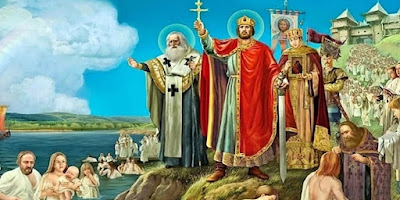Something about the 6th century British monk
Gildas inspired later writers to create elaborate biographies for him.
The first is referred to as the Rhuys Life, since it was written by an anonymous monk at the monastery on the Rhuys Peninsula in the 9th century. He claims Gildas was the son of Caunus, a king in Scotland, with four brothers. When their father dies, one brother comes king and the others become monks. Gildas goes to a monastery under St. Illtud. Gildas becomes ordained in Ireland then returns to northern Britain to preach. The High King of Ireland, Ainmericus (and there was a king Ainmuire Mac Sétnai in the 560s) asks him to restore Christianity to Ireland. After he "fixes" Ireland, he travels to Rome and Ravenna, slays a dragon, and performs miracles. He then settles on the island of Houat off the coast of Brittany as a hermit, during which time he preaches to a woman who is pregnant with St. David (mentioned here).
He later found the monastery at Rhuys and writes a rule book for monks, then later writes a book that criticizes five British kings. He dies on 29 January 570. At his request, the body is placed on a boat and set adrift, but on 11 May 571 the ship comes ashore at Rhuys with the body perfectly preserved, so they bury him at Rhuys. (The picture is a statue of Gildas at Rhuys.)
Gildas' life was greatly elaborated upon in the 12th century by a friend of Geoffrey of Monmouth, Caradoc of Lancarfan. In it, Gildas becomes one of 24 sons of King Nau of Scotia. This is in the time of Arthur, whom Gildas loved. His brother Hueil, however, frequently came down from Scotland to raid, and on one of these excursions he is killed by Arthur. Gildas travels to see Arthur and forgive him.
Gildas then retires to a secret island, but after pirates from the Orkneys carry off his goods and friends, he goes south to Glastonbury, ruled by Melwas, King of the Summer Country (Somerset). Here follows the first time the abduction of Guinevere is mentioned in literature. Melwas abducts her to Glastonbury and rapes her. When Arthur comes to Glastonbury to retrieve his queen, Gildas persuades the two kings to make peace.
There is a Welsh genealogical tract, Bonedd y Saint ("Descent of the Saints"), whose oldest manuscripts date from the 13th century, that credits Gildas with three sons and a daughter. Except for their names, however, we know nothing more about them.
Gildas' lived at the right time to be incorporated into the fascination with King Arthur. There is another link between Gildas' life and Arthur, actually, and that is through his first mentor, St. Illtud. Who was St. Illtud, and what was his link to Arthur? I'll tell you tomorrow.













.JPG)
